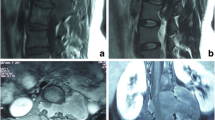Summary
A giant ganglioneuroma generating a progressive scoliosis in a 16-year-old girl is presented. The interval between the start of the orthopaedic treatment and the diagnosis of the true nature of the disease was more than 4 years, thus allowing the development of a giant partly intracanalicularly partly retroperitonealy expanding tumormass. The report emphasizes and describes the combined neurosurgical, general surgical and orthopaedic surgical treatment and presents the results of light- and electron microsopical, immunohistochemical and quantitative neurochemical investigations of the resected tumor.
Zusammenfassung
Es wird über ein riesenhaftes Ganglioneurom als Ursache für eine progrediente Lumbalskoliose bei einem 16jährigen Mädchen berichtet. Zwischen dem Beginn der orthopädischen Skoliosebehandlung und der Diagnose der wahren Ursache der Skoliose sind mehr als 4 Jahre vergangen, so daß ein riesenhafter, teils intrakanalikulär, teils retroperitoneal wachsender Tumor sowie die Destruktion von 4 Lendenwirbelkörpern entstehen konnte. Neben der Beschreibung der kombinierten neurochirurgischen allgemeinchirurgischen und orthopädich-chirurgischen Therapie werden die Ergebnisse der licht-, immun- und elektronenmikroskopischen Untersuchungen sowie neurochemischen Analysen des resezierten Tumors mitgeteilt.
Similar content being viewed by others
References
Berliner P, Unsicker K (1985) Tetanus toxin labeling as a novel rapid and highly specific tool in human neuroblastoma differential diagnosis. Cancer 56:419–423
Berthold F, Kracht J, Lampert F, Millar TJ, Müller TH, Reither M, Unsicker K (1982) Ultrastructural, biochemical, and cell culture studies of a presumed extraskeletal ewing's sarcoma with special references to differential diagnosis from neuroblastoma. J Cancer Res Clin Oncol 103:293–304
Eisenheiss JA (1951)Ganglioneuromas of the paravertebral sympathetic system invading the spinal canal (dumbbell tumours). Review of literature and report of additional case. Bull, Los Angeles remol 16, 194–201
Fakharani-Hein M, Griss P, Lütke A, Bittinger A (1988) Rapidly developping scoliosis in an adolescent due to spinal osteoblastoma. A case report. Arch Orthop Trauma Surg 107:259–262
Gitlow St E, Dziedzic LB, Dziedzik St W (1982) Patterns of catecholamine metabolism in neuroblastoma. In: Pochedly C (ed) Neuroblastoma, clinical and biological manifestations, Chap 7. Elsevier New York Amsterdam, pp 97–130
Griss P, Zielke K, Harms J: Anterior instrumentation and fusion. In: Dickson RA, Bradford DS (eds) Management of spinal deformities, vol 2 Butterworths, London Boston Durban, p 193
Holzbauer M, Sharman DF (1972) The distribution of catecholamines in vertebrates. In: Eichler O, Farah A, Herken B, Welch AD (eds) Handbook of experimental pharmacology XXXIII, Chap 5. Springer, Berlin Heidelberg New York, pp 110–185
Kramer JR (1973) Tumors of nerves. In: Vinken PJ, Bruyn GW (eds) Handbook of clinical neurology. Diseases of nerves, part II, pp 412–512
Lowry OH, Rosenbrough NJ, Farr AL, Randall RJ (1951) Protein measurement with the Folin phenol reagent. J Biol Chem 193:265–275
Machin GA (1982) Histogenesis and histopathology of neuroblastoma. In: Pochedly C (ed) Neuroblastoma, clinical and biological manifestations, Chap 11. Elsevier, New York Amsterdam, pp 195–231
Müller TH, Unsicker K (1981) High-performance liquid chromatography with electrochemical detection as a highly efficient tool for studying catecholaminergic system. I. Quantification of noradrenaline, adrenaline and dopamine in cultured adrenal medullary cells. J Neurosci Methods 4:39–52
Müller TH, Unsicker K (1986) Nerve growth factor and dexamethasone modulate synthesis and storage of catecholamines in cultured rat adrenal medullary cells: dependence on postnatal age. J Neurochem 46:516–524
Nittner K (1952) Klinische Fehlbeurteilung eines lumbalen Sanduhrganglioneuroms. Zentralbl Neurochir 12:167–174
Nittner K (1975) Spinal meningiomas, neurinomas and neurofibromas, and hourglass tumors. In: Vinken PJ, Bruyn GW (eds) Handbook of clinical neurology. Tumors of the spine and spinal cord, part II, chap 7, pp 177–322
Nittner K (1986) Extradurale raumfordernde Prozesse. In: Hopf HK, Poeck K, Schliack H (eds) Neurologie in Praxis und Klinik, Bd III. Thieme, Stuttgart New York
Reynolds CP, Smith RG (1982) Diagnostic and biologic markers for neuroblastoma. In: Pochedly C (ed) Neuroblastoma, Chap 8. Elsevier, New York Amsterdam, pp 131–167
Shephard RH, Sutton D (1958) Dumbbell ganglioneuromata of the spine with a report four cases. Br J Surg 45:305–317
Author information
Authors and Affiliations
Rights and permissions
About this article
Cite this article
Bauer, B.L., Bauer, H., Griss, P. et al. Dumb-bell ganglioneuroma of the spine misinterpreted as progressive idiopathic scoliosis. Arch Orthop Trauma Surg 108, 189–194 (1989). https://doi.org/10.1007/BF00934267
Received:
Accepted:
Issue Date:
DOI: https://doi.org/10.1007/BF00934267




